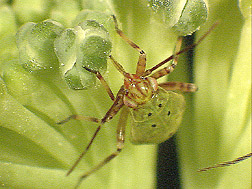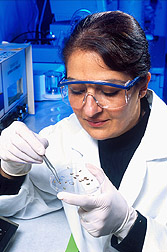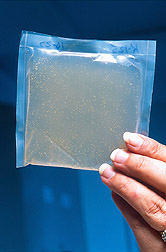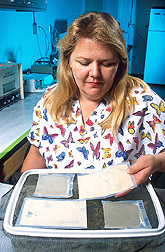High-Performance Insect Diets
|
|
|
|
Relying on insects that prey on crop pests can have a serious drawback: By the time predator numbers become large enough to do a top-rate control job, the pests have already started taking an economic toll on the crop. But it's been prohibitively expensive to rear massive numbers of predators in captivity for release into fields at the most opportune time. Rearing enough host insects to satisfy the predators' voracious appetites, after all, doesn't come cheap.
That's why ARS scientists are searching for artificial diets that will satisfy the palates of beneficial insects, such as the spined soldier bug, the two-spotted stink bug, the big-eyed bug, and the minute pirate bug. Simply providing a cheap diet that will keep the beneficial insects alive is not the final answer, says Thomas A. Coudron, a chemist at the ARS Biological Control of Insects Laboratory, in Columbia, Missouri. The diets must also help the insects thrive and produce multitudes of offspring fit for the field.
|
|
|
Coudron and his colleagues have been combining their expertise in insect biochemistry and physiology to improve the prospects for using beneficial insects. Currently sold mostly to organic gardens and greenhouses, these helpful bugs already make up a $750-million-per-year business. But releasing them in large numbers to help protect field crops—not just organic gardens and greenhouses—will only make sense if the cost of rearing the insects can be significantly decreased, says Coudron.
ARS has already made progress toward this goal. Captive-reared lacewings,Chrysoperla carnea, once required an insect-egg diet costing more than $300 per pound. By 1997, ARS had developed a lacewing diet that could be produced for $2.50 per pound. The artificial diet, invented by entomologist Allen C. Cohen, now at the ARS Biological Control and Mass Rearing Research Unit, Mississippi State, Mississippi, also works for the big-eyed bug,Geocoris punctipes. This predator and the lacewing have voracious appetites for a wide range of plant-feeding insects, such as whiteflies, aphids, scale insects, moth eggs and larvae, and mealybugs.
|
|
|
Cohen and his colleagues at Mississippi State also developed biochemical and biological tests that commercial insectaries can use to quickly and accurately determine whether or not insects reared on artificial diets are able to devour large quantities of pest insects.
Artificial diets are also being developed to feed captive host pests. These insects are used in mass-rearing of beneficial predators and parasites. Cohen is trying various combinations of a basic recipe, which consists mainly of cooked chicken eggs, lima bean meal, wheat germ, soy flour, yeast, vitamins, and preservatives. "The diets differ from one another in their nutritional quality," says Cohen. To determine which recipe gets the blue ribbon, the researchers measure differences in the pests' weight, longevity, biomass accumulation, and fecundity.
|
| The scientists have proven that there is a correlation between a better diet and an increase in egg production. They used tests such as colorimetry, electrophoresis, and enzyme-linked immunosorbent assay (ELISA) to measure protein in the insect eggs. ELISA is based on the ability of an antibody to recognize and bind to a specific antigen, thereby identifying yolk proteins in the adult females and the eggs.
Test results were clear. One example is a diet forLygus hesperus, a destructive bug that devours cotton plants.L. hesperus bugs reared on a diet of chicken egg and a plant product, rather than chicken egg and a meat paste, had more yolk proteins in their hemolymph and eggs. This measurement is predictive of a healthier insect and an adult with higher egg-producing capacity. "This means that a simple immunological/biochemical test can be used early in the rearing process to predict that a diet or other rearing condition is good for or harmful to the insects," says Cohen. This translates into fewer insect losses and significant cost savings for producers. |
|
|
|
By linking research in the areas of physiology, biochemistry, genetics, nutrition, and digestion, Cohen hopes to further improve the formulation and long-term storage of artificial diets—with the ultimate goal of making mass-rearing efficient and economical. Coudron is also working on part of an immunological/biochemical test that would link to a method developed by ARS entomologist Terrance S. Adams to score the reproductive potential of spined soldier bugs and two-spotted stink bugs. The spined soldier bug feeds on more than 50 species of insects, and both predators feed on the Colorado potato beetle, a major pest of potatoes and related plants. Adams is at the Red River Valley Agricultural Research Center, Fargo, North Dakota. By tracing the biochemistry and physiology of egg production, he and Coudron are looking for ways to alter the diet, perhaps for different production stages, to tune up the bugs' nutritional, endocrine, and reproductive systems.
|
|
|
The fine-tuning may result in an increase in fertile egg production in insectaries that will far exceed the reproductive capacity of beneficial insects in nature, says Coudron. That's because of a tradeoff: Faced with fluctuating food supplies in the wild, adults may be programmed to enhance their chances for survival by producing fewer eggs. The study of dietary effects on reproduction could help lead to year-round production of beneficial insects and their eggs. This would allow more efficient use of insectaries and encourage commercial investment in them.—Ben Hardin, and Jesús García,Agricultural Research Service Information Staff. This research is part of Crop Protection and Quarantine, an ARS National Program (#304) described on the World Wide Web at http://www.nps.ars.usda.gov. Thomas A. Coudron is with the USDA-ARS Biological Control of Insects Research Laboratory, 1503 South Providence Rd., Research Park, Columbia, MO 65203; phone (573) 875-5361, fax (573) 875-4261. Allen C. Cohen is in the USDA-ARS Biological Control and Mass Rearing Research Unit, P.O. Box 5367, Mississippi State, MS 39762; phone (662) 320-7560, fax (662) 320-7571. Terrance S. Adams is with the USDA-ARS Red River Valley Agricultural Research Center, P.O. Box 5674, University Station, Fargo, ND 58105; phone (701) 239-1277, fax (701) 239-1202. |
|
"High-Performance Insect Diets" was published in the February 2001 issue of Agricultural Research magazine. |
|












